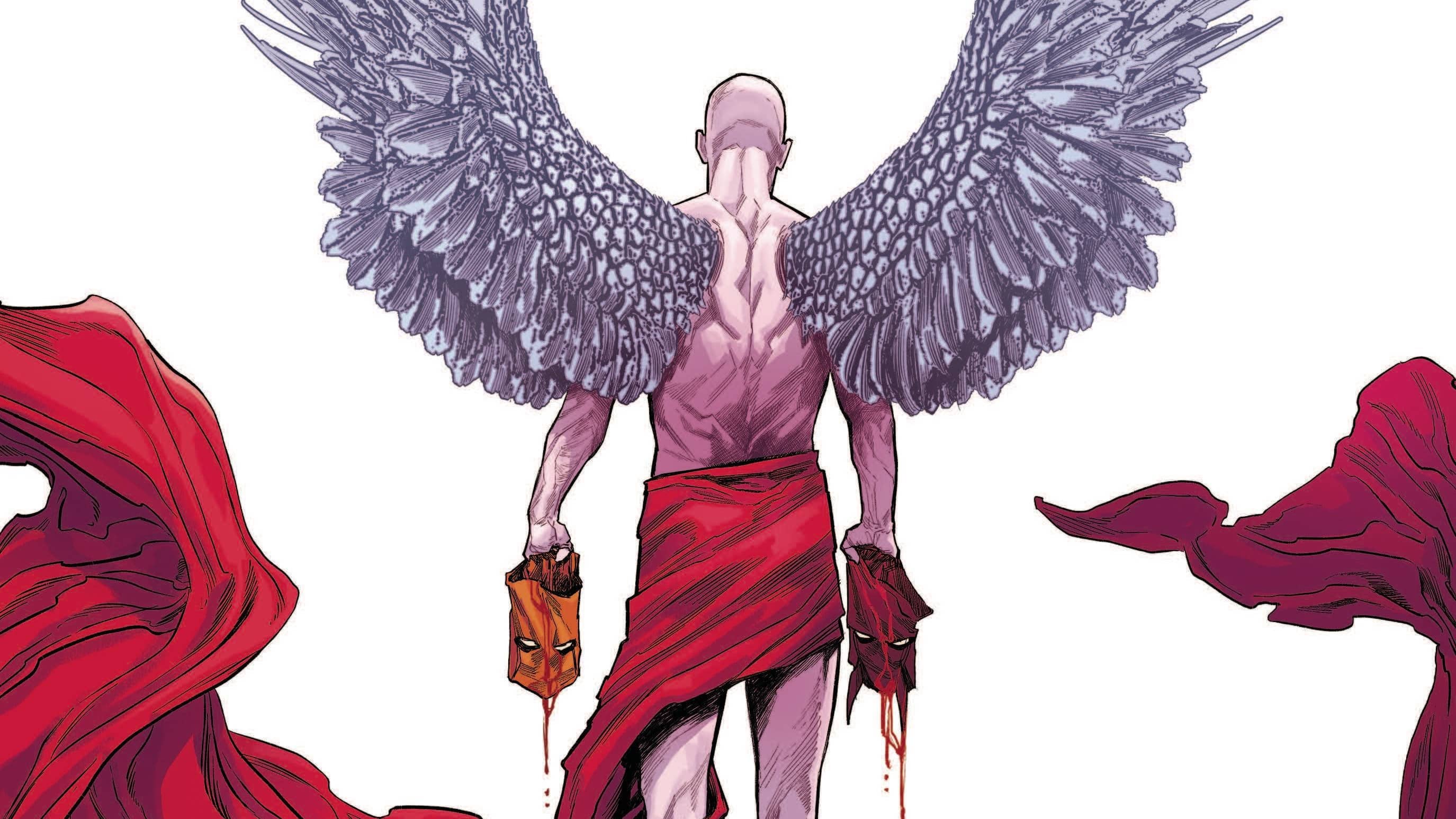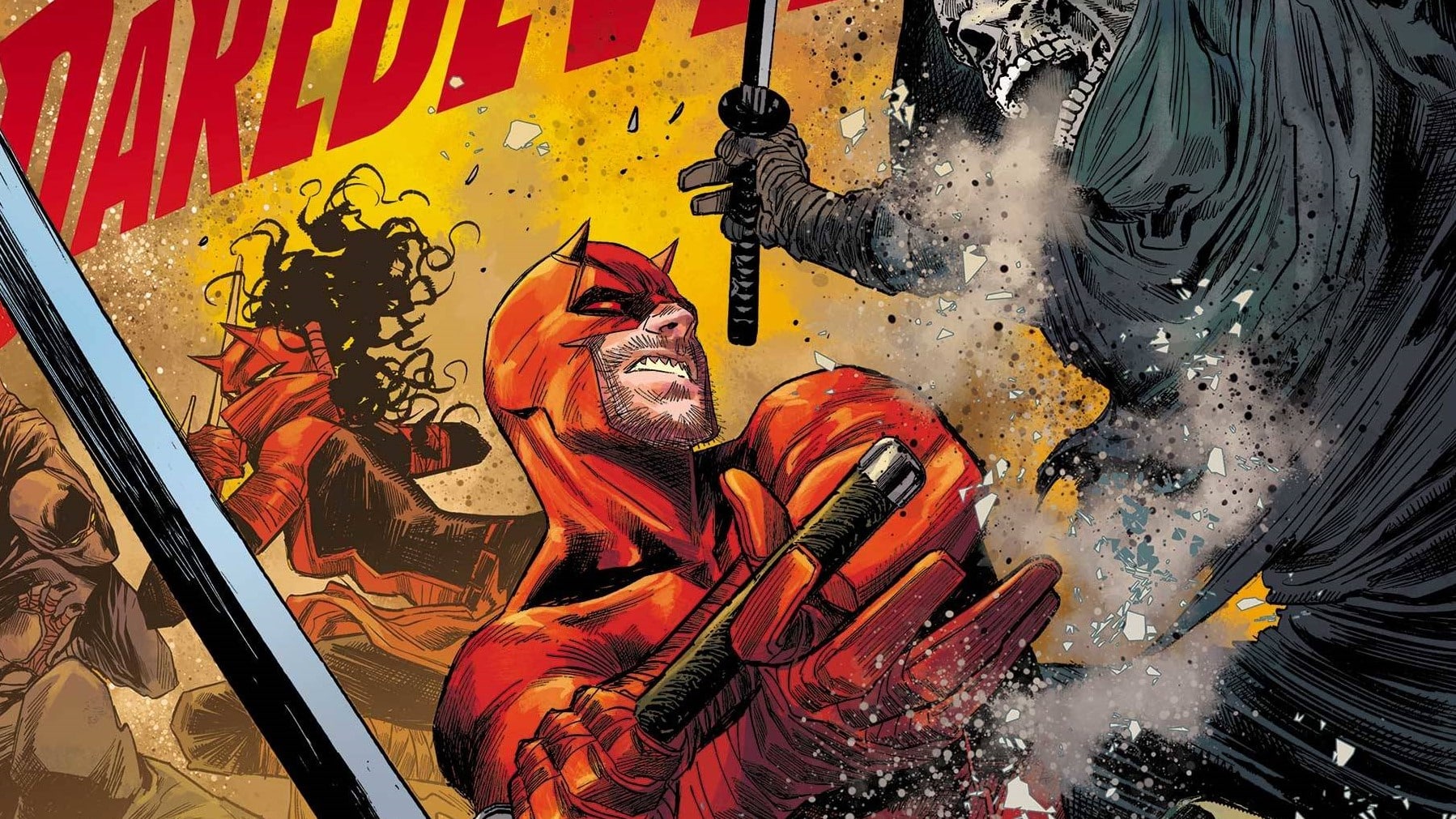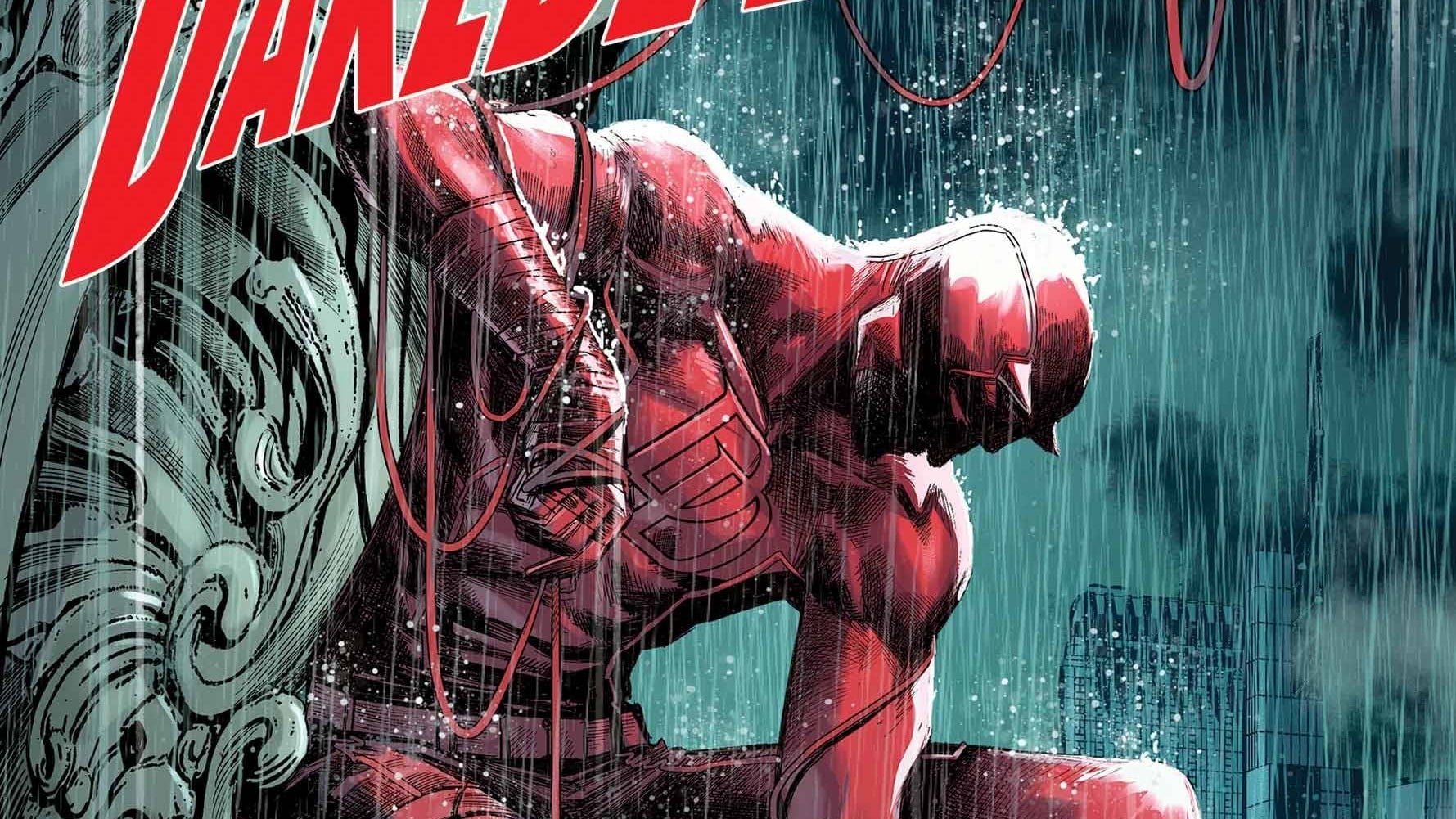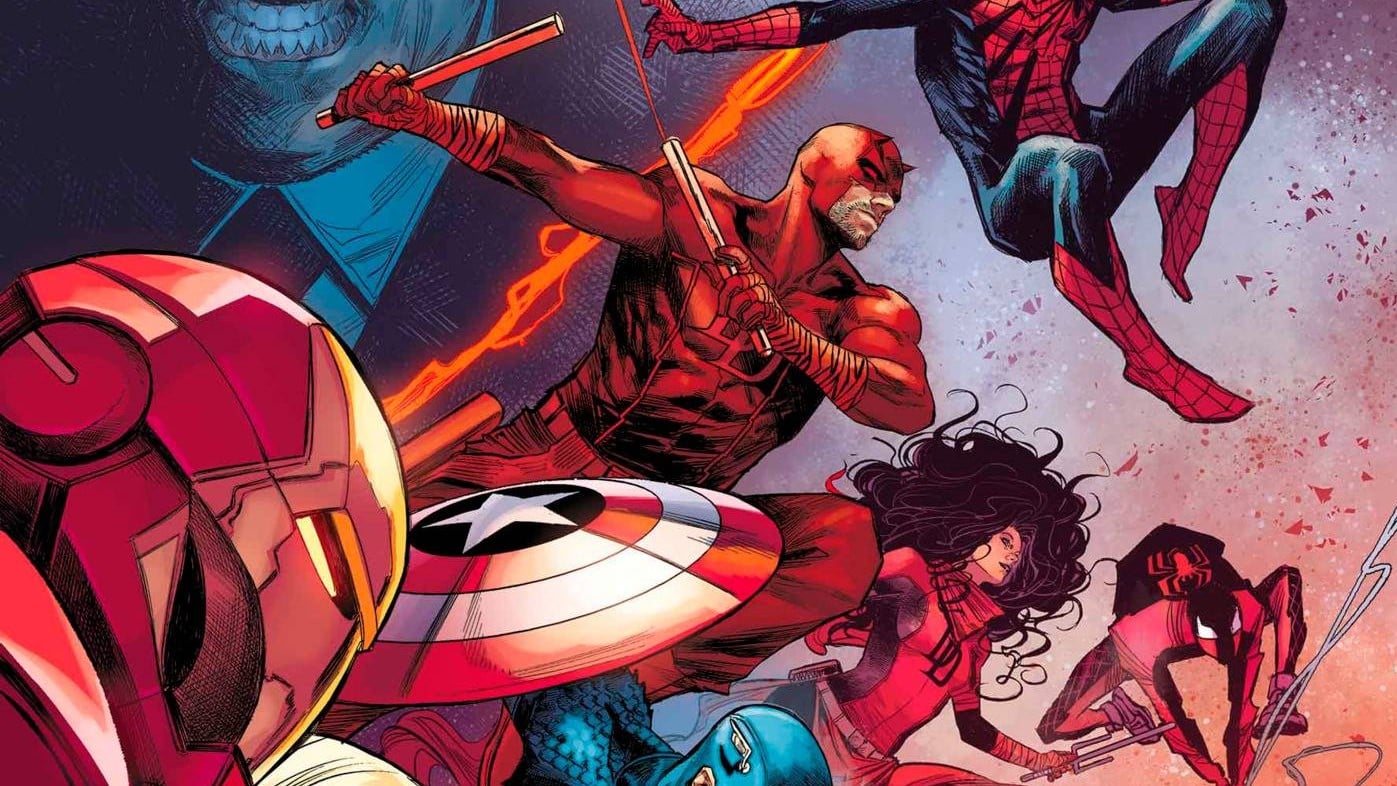The former and current Daredevils have had enough and Bullyseye’s just getting started in Daredevil #31. Written by Chip Zdarsky, drawn by Mike Hawthorne, inked by Adriano Di Benedetto, colored by Marcio Menyz, and lettered by Clayton Cowles, Daredevil #31 sees Matt waking up to realities of life on the inside, while Elektra wakes up to realities of parenthood, and Bullseye wakes up… different.
Anna Peppard: Welcome back to Speak of the Devil! Jubilant Justin Partridge is away this month due to technical difficulties (which is not code for anything – he literally had technical difficulties!). God willing (assuming blessing busted computers isn’t beneath the notice of the almighty), Justin will return next month. In the meantime, I’ve recruited a new partner in rants and raves – none other than Resplendent Rob Secundus!
Rob Secundus: Happy to be here! I’ve loved this run thus far – it’s my favorite Daredevil run in the modern era, at least since the Marvel Knights relaunch – and one moment in particular this week hit my Extremely Specific Daredevil Buttons.
Anna: Glad to hear it! I am also happy to be here, reviewing a book I liked just fine. It’s old news now that I haven’t always loved this run as much as I want to, but I will say – I deeply admire its consistency. Even here, with Mike Hawthorne filling in for regular artist Marco Checchetto and an overall “setting things up for future issues” feel, this was a solid issue with thoughtful plotting and some great individual moments. Let’s dig in!
Heroic Parallels

Anna: Proceedings open with us checking in on Matt and Elektra in their respective locales, confronting repercussions from the last couple of issues. Matt’s back in prison, still dealing with the injuries he sustained in the yard attack in issue #29 and contemplating the new mission he acquired in issue #30, in which he became an FBI informant regarding a suspicious prison labor program. Once again, he has his hubris called out by fellow prisoner Marcus. Once again, he doesn’t seem to listen. Elektra, meanwhile, is dealing with her ward Alice’s understandably emotional response to shooting a guy to protect Elektra during the warehouse brawl. For some reason, Elektra’s reassurance that the guy wasn’t alive anyway – since he was a resurrected Hand soldier composed of dust and magic – doesn’t make Alice feel better. She calls Elektra a “crazy #$@%” and storms out. Elektra is… displeased.
I liked the ways Matt and Elektra’s stories parallelled and reflected each other, in general and in these opening scenes in particular, where Hawthorne’s art and Manyz’s colors did some interesting things communicating those thematic relationships. The scenes with Matt in prison are drab, dull, and claustrophobic, while Elektra’s loft is airy and glowingly bright, courtesy of her huge highrise picture window – always a useful symbol for showing someone who’s both connected to the city and isolated (or alienated) from its sweaty bustle.
Yet Matt’s situation and personality are very similar to Elektra’s. Matt’s trapped not by walls, but by his own single-minded stubbornness, which Marcus, echoing Kirsten in the last issue, suggests is also a form of selfishness. And Elektra’s freedom is an illusion; she’s trapped by the same circular stubbornness, trying to turn Alice into a version of herself before falling back into familiar habits, riding her anger and arrogance into a flurry of violence that gets her into a room with Izzy Libris, but doesn’t get her what she wants. Because it turns out Izzy is trapped too, by cycles of violence leading to grief leading to a deal with the Hand, which can only lead to more grief and violence.
Rob: I think, in Matt’s case, what this arc is exploring in that trap, in those cycles, is a very Catholic idea of (and problem with) notions of penance and atonement. There are a few, I think, valuable ideas in the whole Catholic conception of “confession,” but ideas that are also easily harmful. The theological foundation of the sacrament – in opposition to the Protestant notion that sin is between you and God – is that you must confess to an appointed member of your community, because any ill you do harms not only yourself but also that community, even if there’s no clear, apparent harm done, because every person in that community is metaphysically connected. Real atonement and contrition is necessary, and then honest admission of guilt is necessary, but the sacrament is not complete until after one has left the confessional and performed an assigned penance, typically a set of meditative prayers, though occasionally some more concrete reparative actions.
In devout Catholic practice, the Catholic is not supposed to fully participate in the community – they are barred from the eucharist, the sacrament literally called “communion” – until that penance is complete, until the individual has completed that reflection, meditation, or reparative action. Matt has adopted the American Legal System as his confessor, and he’s taking sentencing for that penance. But the confessional – a place where religious patriarchs speak to those under their authority with the presumed backing of their God – has historically been often, often severely abused, and substituting out the priest for the carceral state doesn’t exactly help. Even in situations utterly devoid of abuse, the confessional is often a place of stagnation.
Penance is ideally designed to bring about real growth in the individual and real reunification with the community, but in practice it is typically empty. Three Hail Marys are recited not like a meditation, a space for reflection, but like a spell that will excuse your own failings. We’re seeing that with Matt’s penance here. By so single-mindedly insisting on his penance, he’s fighting against the intended outcome of penance: change.
Anna: That reminds me of a complaint I made way back in my first appearance in this column, about Zdarsky’s Matt being too Catholic. That’s not meant to sound anti-Catholic. (All religions are diverse and complicated!) It’s just that in the past, I’ve perceived Matt’s spiritual and cultural influences as being more diffuse, combining Western and Eastern faiths and philosophies. To me, he’s felt a bit cut off from that in this series in ways I find frustrating, since it can read like stagnation or even regression; Matt seems, to me, like he’s learning lessons he’s learned before. But of course – that’s a common complaint of long-running serialized stories, and remains very subjective.
At least Matt does take a different tack here – going straight after the warden with reckless confidence and a Mike Murdock-esque smile. Yet this doesn’t feel like a step forward since if anything, he’s behaving even more individualistically than before. I continue to wish I found it easier to believe in Matt in this series, rather than always shaking my head at his latest step toward the next inevitable cumuppenance. I’m still rooting for him, but if I’m being completely honest, I prefer being able to love him, and right now, I can’t quite get there. I know that’s probably the point; we’re deconstructing the problematic fantasies this straight white man profers. But still.
Rob: I think going after the warden too just confirms Matt further in his myopic ideas of justice. This run has largely focused on how deeply unjust American institutions are at every level. The police are corrupt, the politicians are corrupt, and they both are nothing compared to the people those institutions actually serve, the ruling class. Matt still thinks there’s just a Bad Guy in the system he can take out, rather than recognizing that the system itself is designed to allow people like this warden to flourish, and to flourish by exploiting those in their power.
Anna: It seems a touch strange to me that Matt wouldn’t already understand the broken-ness of the system, given the fact he’s both a lawyer and a vigilante, but I know what you mean; Matt’s not properly aware of the full extent of the system’s broken-ness, or his implication in maintaining the system through his privileged belief in the promise of justice (either legal or spiritual).
Though Elektra is also caught up in repetitive cycles, I have some hope she might be moving toward something new – a more complicated understanding of her relationship with the community around her or even a better understanding of herself and what drives her.
A few art notes, relevant to Elektra: though I always miss Checchetto, Hawthorne does a good job maintaining the series tone. And as we discussed in the last column, I like him a lot on the quiet character-building scenes. I particularly loved his posture and expression work for “civilian” Elektra. We’re not so far removed from every single female character in every single superhero comic constantly mugging for the male gaze that I don’t notice and appreciate depictions of women that make them look strong, sexy, and human. Elektra’s characterization (both narratively and visually) is definitely the thing I like best about this series as a whole; she’s rarely felt as real to me as she does in this series, and this issue continues that trend.
Villainous Parallels

Anna: Some of the series’ villains are similarly dealing with repercussions; others are setting new schemes in motion. Mike Murdock – who is still impersonating Matt – is presented at a top-secret meeting with all the Hell’s Kitchen crime bosses who aren’t Wilson Fisk or Izzy Libris. Hammerhead et al aren’t especially eager to trust this (supposed) “former ex-assistant D.A.,” and they shouldn’t, since Mike’s buddy Butch – the still-mysterious son of Fisk – is in the corner rocking a beanie, a cool slouch, and a very smug smile. But Mike makes the proverbial offer they can’t refuse. He says the D.A. is preparing to take down Izzy Libris. The other crime bosses can either wait for that to happen, possibly going down with her, or take her out themselves. Hammerhead roughs up Mike before saying “screw it,” while Mike and Butch exchange a knowing look.
What did you think of this development, Rob? Did it add intrigue, or was this mob coup too paint-by-numbers?
Rob: This plotline continues to bring me joy because it is very paint-by-numbers – but it’s a paint-by-numbers mob coup featuring Matt Murdock’s fictional alter-ego turned sentient, independent, living fiction incarnate, and then finally turned Real Boy, and his best friend, a Kingpin Jr who did not exist until said walking-fiction got his hands on reality-warping magic. It’s the kind of utter bonkers nonsense that can’t happen outside of not just comics, but extremely long-running, shared universe superhero comics. And I’m invested in Wilson Fisk’s timeline baby and Matt Murdock’s newly-real grifting brother as characters rather than just buck wild gimmicks.
Anna: Well when you put it like that… I am now 110% on board! You’ve perfectly described what I similarly adore about Mike. I also liked the thematic things this issue does with the villains, evoking more parallels and reflections, with each other and with the stories of our heroes. That includes Izzy Libris but also Fisk and Butch, as well as the ever-delightful Mike. Elektra’s excessive violence is very obviously linked to Fisk’s on the page where their shouting, snarling faces mirror each other, each of them performing violent interrogations that are as much for their own benefit as anyone else’s. Questioning the righteousness of heroes by comparing them to villains is hardly a new tactic, but it’s effective.
Rob: One of the things that has cemented this run as my favorite modern Daredevil story is that emphasis on character parallels and foils. I find it brings the narrative a sharp focus beyond most contemporary superhero comics. But when it comes to Butch and Mike – the two characters who are most clearly reflections of other characters in the series – I don’t know what they’re doing here yet. I don’t really understand what Mike has to say about Matt, or Butch about Fisk. This isn’t a critique, though; it feels like they’re headed somewhere, and I’m excited for that picture to become clearer.
Anna: I remain excited for Mike to replace Matt permanently. (I’m kidding, of course! Or am I…???)
Eye on Bullseye

Anna: We’ve been building to the return of Bullseye for a while now, with glimpses of him trapped in stasis in a super-scientific lab before his breakout at the end of the last issue. Fisk is desperate to get Lester back; trying to find Bullseye is most of what our not-so-honorable mayor gets up to in this issue. While it’s understandable Fisk wouldn’t want Bullseye in the wind and outside his control, we still don’t know what Fisk was doing to him in the lab. We also know little, at this point, about Bullseye’s personal goals; we only know he’s free, armed, and deadly as ever. Wait, I lied, we know one other thing – that Bullseye now has an angel who talks to him, imparting upon Lester a holy mission to kill everyone.
I wasn’t the biggest fan of the scene at the end of the issue where Bullsye shoots the anonymous man in the crowd. I wasn’t shocked by it; guns, and the things that guns do, are nearly as common in superhero comics as they are in every other action genre, and I’ve seen Bullyseye do this type of thing many times before. I also know it’s hypocritical of me to criticize the violence here while celebrating beautiful violence elsewhere (as in our previous column, where I praised Checchetto’s dreamy, psychedelic rendition of the warehouse fight). And yet, guns in superhero comics, especially when they’re being used against non-superpowered civilians, always make me uncomfortable; it’s an intrusion of real(ish) violence into a space of fantasy violence, and this scene in particular, with its mass shooter vibes, was a bit too real for me. Don’t get me wrong – intrusions of realistic violence can be productive. It can be valuable to remind us of the consequences of violence within a genre that often glosses over them. But for me, it depends how it’s handled.
Here, this intrusion of real(ish) violence was aestheticized and spectacularized in ways that glorified Bullyeye’s power; the man Bullyeye shoots is caught in a moment of frozen, weightless grace before his fall, and on the final page, we’re positioned on the ground between Bullseye’s legs looking up at his crotch and perfectly sculpted body as he celebrates his kill. Again- there’s nothing particularly unusual about this scene. I’m not calling out this comic for some out-of-bounds offense. But I have been wondering more and more in recent years – especially in and around the use of superhero symbols by the militant alt-right – whether it’s worth thinking more deeply about the functions of such images. This scene presents a very disturbing power fantasy while doing very little (if anything) to critique it.
Then again: maybe this scene stood out because this series is usually more thoughtful about the consequences of violence. That’s kind of the central theme, after all, and it continues to take new forms month after month. Just thought I’d mention it as something to keep an eye on moving forward.
Rob: As a Columbine and DC Sniper era kid, these types of scenes should be too real for me, but at this point I suppose I’m far too desensitized? That desensitization in and of itself, I think, should condemn the ongoing approaches to depicting gun-violence, particularly in escapist media. Weirdly, I think the visuals might be more successful if it pushed it further into glorification; if, instead of standard Male Superhero Glorification, the art went further to depicting a beautiful, or transcendent Bullseye, the contrast between the beauty of the art and the horror of the violence might have resulted in something shocking, something appropriately grotesque. Or, on the other hand, Bullseye could be denied the standard Male Superhero Glorification and depicted as something disgusting. Or – but no, I’m not going to keep listing what if’s. I think there are a large number of ways this scene could be rethought successfully, but as it actually stands it feels thoughtless. As you say, glossed over.
If I treat this development in the abstract (which is, I know, often not a very productive way to approach art like this, when the cultural context is so serious, so important), I like the shift in Bullseye. I’ve never cared for the character; to me, he’s like the Joker, but even more boring. In his essence, he’s just a guy who is good at doing violence and not feeling guilty about it, which is the least interesting antagonist for a guy whose deal is he’s good at violence but feels very guilty about it. Too often he feels less like a character and more like a narrative tool to inflict misery on Matt and his supporting cast, and thus plays into all the worst (and often misogynistic) impulses of Daredevil writers. To give him an actual goal, and an extreme one at that – a motivation that is comparable to Thanos’ in some depictions – fixes the character for me. He has a cosmic-level goal.
He’s not just an assassin now, but someone devoted to the assassination of all sentient life, but also without any kind of cosmic-level tools. He has no infinity gauntlet to snap. I would have been happy to never see the character appear in this run, but this shift leaves him ready for more interesting stories than getting hired to kill someone, or killing someone to piss off someone else. That he’s got an evil angel in his brain put there by the state as it attempts to use his violence for its own benefit – for me, that sets him up to play thematically with both Matt and Fisk in really interesting ways moving forward.
But if I step back into reality again, if I no longer stay abstract – is any of that worth it? Is making a supervillain more interesting or narratively utile worth the cost of putting a mass shooting into an escapist adventure story with superheroes sold to children? I really don’t know. It probably isn’t worth it.
Anna: I love that reading of what’s going on with Bullysye and his angel. I also love those suggestions for how different visualizations might have generated different meanings. While I like Hawthore’s style, it’s certainly more staid than Checchetto’s; I can imagine Checchetto communicating the spooky religiosity you’re describing more effectively than Hawthorne did here.
Though I admit your critiques of Bullseye are totally justified, I have historically liked him. I enjoy his single-minded-ness and pathetic-ness; he doesn’t even try to disguise the fact he’s centrally motivated by a fear of not measuring up to Matt. Then again, probably my favorite modern-ish take on Bullseye was in the Bendis/Maleev run, where he’s teased as a big bad, only for Matt to defeat him easily, and humiliate him to boot (carving that bullseye symbol into his forehead). There’s an argument to be made that Matt’s moved beyond the threat Bullseye represents, and maybe that’s what this twist on the character is about. In past columns, I’ve described this series as having something of a “greatest hits” feel. It would be great to see Zdarsky and Co. put a unique stamp on one of Daredevil’s arch nemeses.
Marvelous Musings
- Today in unfortunate ad placement: the tribute to John Paul Leon that was inserted between beats of a comical exchange between Mike Murdock and Hammerhead. Both were lovely; neither benefited from this choice.
- I’m not sure if I’m convinced by Izzy’s remorse. I wouldn’t be surprised if it’s part of a long game.
- I’m worried about Alice. Does she, like, attend school? Does she have any other family? While I’m enjoying Elektra subverting the “motherhood turns a bad woman good” trope by being a decidedly problematic mother, a few more glimpses of Alice and Elektra’s day-to-day realities might help me feel a bit more grounded in that storyline.
- I <3 Mike’s saucy cocked eyebrow after Hammerhead decks him. I also enjoyed Hawthorne’s very shark-like modelling of Hammerhead. Also-also: I looked at a lot of shark pics to figure out why it’s perfect. It’s definitely the wide-set eyes.
- Looks like we’re heading for a showdown between Elektra and Bullseye. That could go a lot of different ways… we’ll have to wait and see!







